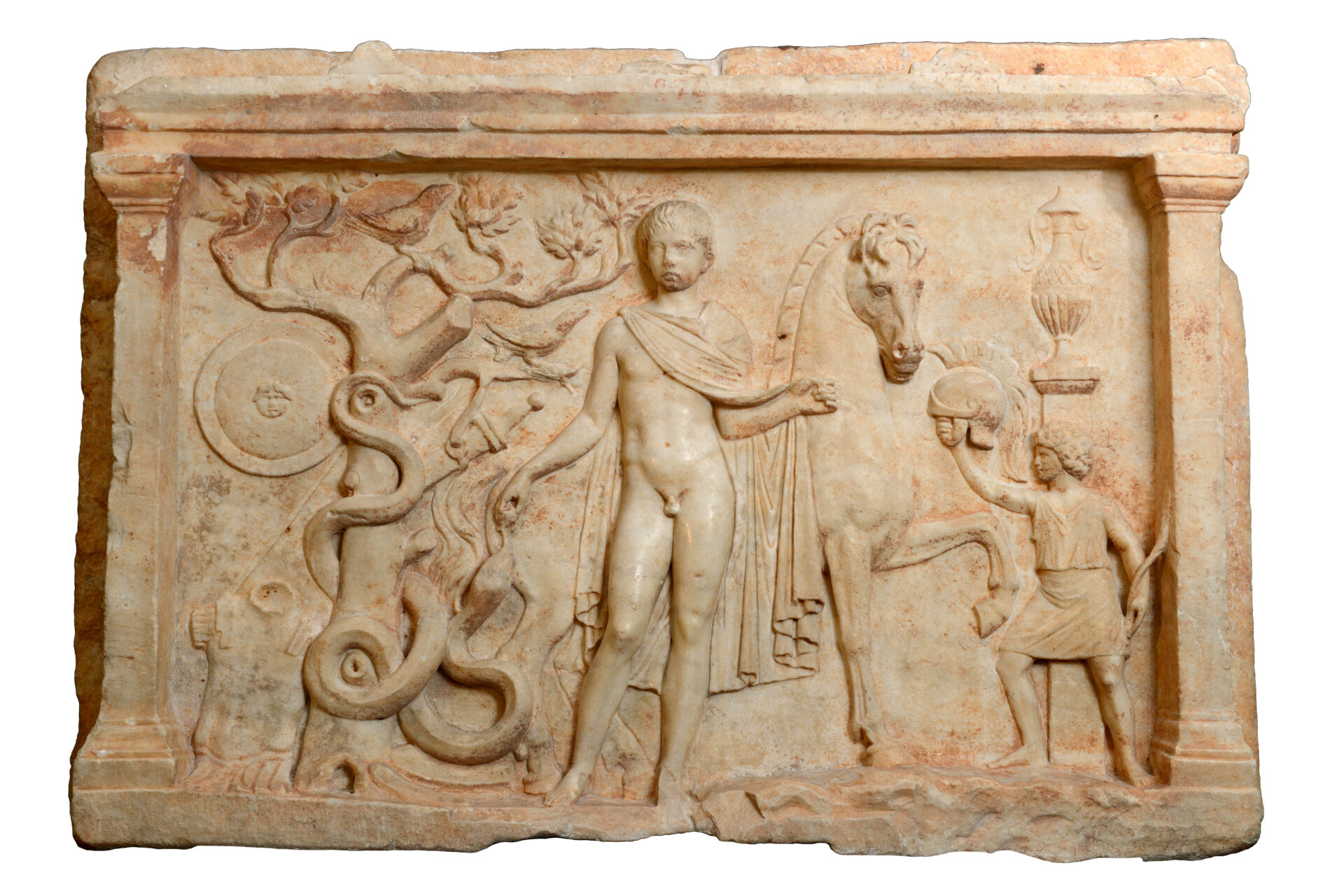Exhibit of the month
A heroon in the nature
Relief of a heroized youth
Hellenic National Archaeological Museum
Sculpture Collection, inv. no. Γ 1450.
Provenance: Collected near the Monastery of Loukou (Arcadia) at the beginning of the 19th century and most probably comes from the nearby villa of Herodes Atticus.
Dimentions: height 0.64 m., width 1.00 m.
Date: AD 150-160
Display: Room 32
A frontal, standing youth is depicted in the middle of a naiskos-shaped relief, wearing just a chlamys covering his back. His face and hairstyle are depicted portrait-like. With his left hand he would have held the reins of the horse, depicted behind him with left front leg raised. With his right hand the youth offers food to a snake coiled around the trunk of an oak tree, on the leaves of which perch two birds. On the branches and next to the trunk are the youth’s arms: a sword with its scabbard, a shield, a spear, a cuirass and greaves. A child servant approaches from the right, presenting his master with a Corinthian helmet. Behind him is a grave pillar with a loutrophoros, indicating the youthful age and the premature death of the unwed man and the scene’s environment in a necropolis. On the other hand, the nudity of the central figure, together with the horse and the armour, suggest the youth’s heroization.
The youth should be identified with one of the young trophimoi of the famous benefactor and sophist Herodes Atticus, Poludeukion or Achilles, due to the depicted armour. Polydeukion’s premature death in adolescence shattered Herodes, who buried him like a hero, organized games in his honour and perpetuated his memory by erecting busts, statues and relief sculptures. In Herodes’ properties were erected statues of Polydeukion as well as of his other two adopted sons, Achilles and Ethiopian Memnon, who perished also prematurely, that represented them as hunters in nature. The relief was found close to the Monastery of Loukou, where a luxurious villa of Herodes Atticus was located. Archaeological research has shown that between 160 and 170 AD, after the loss of Herodes’ family, including his wife and beloved foster sons, a complex in the south part of the villa was transformed[1] into an Heroon-Mausoleum and was adorned with heroic reliefs and marble klinai with reclining figures representing the members of Herodes’ family feasting like heroes. Polydeukion must have also been worshipped there, whereas his posthumous worship had a great impact even on persons of Herodes’ environment[2].
The heroa were devoted to the worship of mythical persons and forefathers, city founders, prominent citizens, heroized dead etc. They were built in precincts, comprising several buildings and constructions, besides the tomb monument, which was the focus of hero worship. According to the accounts of ancient Greek writers, hypaithral heroa had specially designed gardens and often enclosed groves of trees and plants[3]. However, by the Hellenistic period funerary monuments of prominent citizens were also found intra urbem, on the Agora or at the Gymnasium[4]. A symbolic image of the heroized deceased grave monuments is given by the so-called heroic reliefs, such as the one under consideration. In these reliefs, the depictions of pillars surmounted by a grave marker, indicate the necropolis area, as does the tree with a snake, since trees, usually cypresses, were planted in the cemeteries. The snake, a chthonic animal, functions both as a guardian of the tomb and as a symbol of the heroization of the deceased, like the horse and the weapons. Literary evidence also attest to the suspension of weapons in funerary monuments[5].
[1] It was initially used as a Temple-Sanctuary of Antinous-Dionysos, favorite of emperor Hadrian, who was deified by Hadrian after his drowning in the Nile in AD 130. Mantineia was the center of his cult: in the Gymnasium of the city there was the «house of Antinous» with statues and painted depictions of him as Dionysus (Pausanias VIII: 9.7, 10.1).
[2] Philostratus, Vitae Sophistarum, 558-559.
[3] Cf. the grove in the heroon of Pelops in Olympia (Pausanias V:13.1).
[4] The Greek intra-urban grave as phenomenon existed on mainland Greece from 720 BC onwards, but enjoyed great popularity by the Hellenistic times, when the role of benefactors, εὐεργέται, and the heroization of deceased grew in an intense way.
[5] Pausanias VIII: 11. 8, IX: 25. 2.
Dr Chrysanthi Tsouli
Bibliography
K. Ρωμιοπούλου, Eλληνορωμαϊκά Γλυπτά του Εθνικού Aρχαιολογικού Μουσείου, Αθήνα 1997, 92, αρ. 93.
J. Tobin, Herodes Attikos and the City of Athens: Patronage and Conflict Under the Antonines, Amsterdam 1997, 95-96,99-107.
N. Kaltsas, Sculpture in the NationalArchaeological Museum, Athens, Athens and
Los Angeles 2002, 347 αρ. 736.
H.R. Goette, Heroenreliefs von Herodes Atticus fur seine Trophimoi, στο: ΑΓΑΛΜΑ. Μελέτες για την αρχαία πλαστική προς τιμήν του Γιώργου Δεσπίνη, επιμ. Δ. Παντερμαλής, Μ. Τιβέριος, Ε. Βουτυράς, Θεσσαλονίκη 2001, 419-427, ιδ. 424 κ.ε., εικ. 8-9.
E. La Rocca, C. Parisi Presicce, Α. Lo Monaco (επιμ.) L’eta dell’equilibrio, 98-180 d.C.: Traiano, Adriano, Antonino Pio, Marco Aurelio, Roma, Musei Capitolini, 2012, 198, 315-316, αρ. ΙΙΙ 22 (A. Lo Monaco).
E. Calandra, B. Adembri (επιμ.), Adriano e la Grecia. Villa Adriana tra classicita ed ellenismo. La mostra, Tivoli, Villa Adriana, Antiquarium del Canopo, 9 aprile – 2 novembre 2014, ed. Verona 2014, 69-70, αρ. 46 (Μ. Saporiti).
For Herodes Atticus villa in Loukou
G. Spyropoulos, Appropriation and Synthesis in the Villa of Herodes Atticus at Eva (Loukou), Greece, στο J. Spier, S. E. Cole (eds.), J. Paul Getty Museum, 2022, 92-105 and for the Heroon-Mausoleum in the villa idem, 99-101.
Chr. Kanellopoulos, A.V. Karapanagiotou, The North Basilika in Herodes Atticus’ Villa at Eva/Loukou. New Observations on architecture and sculptural decoration, AURA 5, 2021, 251-273.
General Bibliography for graves and funerary monuments of heroes or heroized dead
H. Schörner, Sepulturae graecae intra urbem. Untersuchungen zum Phänomen der intraurbanen Bestattungen bei den Griechen [9. Beiheft Boreas], Möhnesee 2007.
Aik. Tzavelopoulou, Λατρείες ηρώων στις αγορές της αρχαιότητας, chapter 2.2.2.3γ. Ταφικά μνημεία, Diss. National and Kapodistrian University of Athens, 2011, pp. 106 ff., 273-283.


